 |
 |
 |
| |
Lack of a clinically significant drug interaction between BMS-663068, a novel HIV-1 attachment inhibitor, and tenofovir disoproxil fumarate when administered in combination at steady state
|
| |
| |
Reported by Jules Levin
13th International Workshop on Clinical Pharmacology of HIV Therapy
16-18 April 2012, Barcelona, Spain
L. Zhu, C. Hwang, V. Shah, I. Chang, M. Furlong, M. Hruska, G.J. Hanna, R. Bertz. Bristol-Myers Squibb, Princeton, NJ, USA
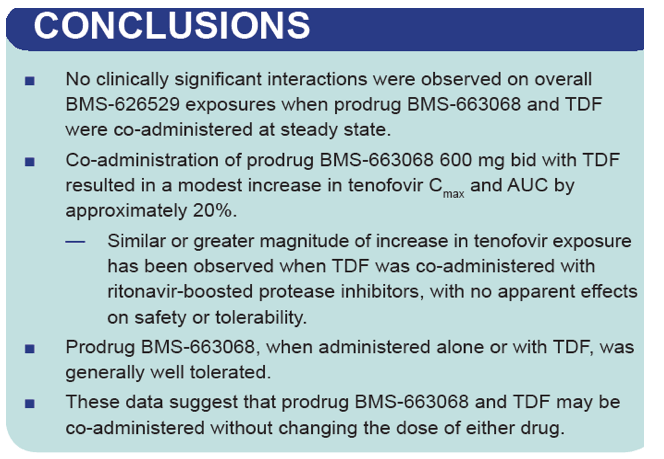
BACKGROUND
BMS-663068 is a methyl phosphate prodrug of BMS-626529, an HIV-1 attachment inhibitor.
-- BMS-626529 represents a novel class of antiretroviral agents that binds to the HIV-1 envelope glycoprotein, gp120, and selectively inhibits the interaction between the virus and its host receptor CD4, thereby preventing the fusion of viral and cellular membranes.
Prodrug BMS-663068 is currently in Phase IIb development in which a range of prodrug BMS-663068 doses given once or twice daily are being investigated.
-- Prodrug BMS-663068 is generally well tolerated when dosed as an extended release (ER) formulation with pharmacokinetic (PK) properties supportive of once or twice daily dosing.1
-- Prodrug BMS-663068 has also shown robust antiviral activity in HIV-1 infected subjects with an overall change from basline in viral RNA of -1.69 log10 copies/mL.2
Following oral doses, prodrug BMS-663068 is rapidly hydrolyzed to BMS-626529 which is metabolized by both the esterase-mediated hydrolysis pathway and by the cytochrome P450 (CYP)-mediated oxidative pathway.
-- Prodrug BMS-663068 and BMS-626529 have not been shown to be inhibitors or inducers of major CYP enzymes.
-- Neither prodrug BMS-663068 or BMS-626529 appear to be significant inhibitors of P-glycoprotein.
Tenofovir disoproxil fumarate (TDF), a nucleotide reverse transcriptase inhibitor (NRTI), is commonly used as the nucleotide backbone component of a cART regimen.3
-- TDF is not metabolized by CYP isoenzymes; it is not an inducer or inhibitor of these enzymes and is primarily excreted in urine by glomerular filtration and active tubular secretion.
-- Despite seemingly not sharing an apparent and common elimination pathway, clinically relevant drug interactions between TDF and protease inhibitors, in the presence or absence of ritonavir (RTV), have been reported.4,5
OBJECTIVE
To assess the effect of TDF 300 mg qd on the steady-state PK of BMS-626529 administered as prodrug BMS-663068 600 mg bid and vice versa in healthy subjects.
METHODS
Study design
- This was a Phase I open-label, 1-sequence, 3-period, 2-way interaction, multiple-dose study in healthy subjects (Figure 1).
- Eighteen healthy volunteers were enrolled. All subjects completed the study and were included in the evaluable PK and safety populations
- On Days 1-5, all subjects received oral doses of prodrug BMS-663068 ER 600 mg bid (Treatment A). On Days 6-12, all subjects received oral doses of 300 mg of TDF qd (Treatment B). On Days 13-19, all subjects received oral doses of prodrug BMS-663068 ER 600 mg bid plus oral doses of 300 mg of TDF qd (Treatment C).
- Subjects were confined to the clinical facility for the entire treatment period and discharged on Day 21 upon completion of all final evaluations.
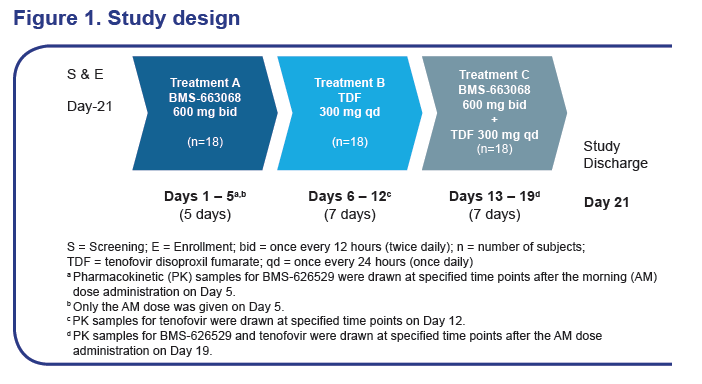
Eligibility criteria
Main inclusion criteria
- Healthy subjects aged 18-49 years, inclusive
- BMI 18-32 km/m2, inclusive
- No clinically significant deviation from normal in medical history, physical examination, ECGs or clinical laboratory assessments
Main exclusion criteria
- HIV infection
- Any significant acute or chronic medical illness
- History of allergy to HIV-1 attachment inhibitors, protease inhibitors or NRTIs
- Pregnancy or breast-feeding
Assessments
Pharmacokinetic parameters of BMS-626529 and tenofovir were estimated using noncompartmental methods and included:
- maximum observed plasma concentration (Cmax),
- time of Cmax (Tmax),
- area under the plasma concentration-time curve (AUC) in 1 dosing interval (AUC[TAU]; time 0 to 12 hours post-dose for BMS-626529; time 0 to 24 hours post-dose for TDF),
- concentration prior to the dose (C0),
- concentration at 12 hours post-dose (C12) for BMS-626529 only
- concentration at 24 hours post-dose (C24) for tenofovir only.
Safety assessments were based on medical review of adverse event reports and the results of vital sign measurements, ECGs, physical examinations, and clinical laboratory tests.
Statistical analyses
- To assess the effect of TDF on the steady-state PK of BMS-626529, point estimates and 90% confidence intervals (CIs) for the ratio of the geometric means for BMS-626529 Cmax, AUC[TAU], C0, and C12 when prodrug BMS-663068 was administered with and without TDF were constructed.
- To assess the effect of prodrug BMS-663068 on the steady-state PK of tenofovir, point estimates and 90% CIs for the ratio of the geometric means for tenofovir Cmax, AUC[TAU], C0, and C24 when TDF was administered with and without prodrug BMS-663068 were constructed.
- For both drugs, estimates were generated using linear mixed models on log-transformed data, with treatment as a fixed effect, and measurements within each subject as repeated measures.
RESULTS
Effect of TDF on steady-state PK of BMS-626529
Mean BMS-626529 plasma concentrations were comparable after prodrug BMS-663068 was administered alone or co-administered with TDF (Figure 2).
Tmax for BMS-626529, either alone or co-administered with TDF, was approximately 5 hours (Figure 2).
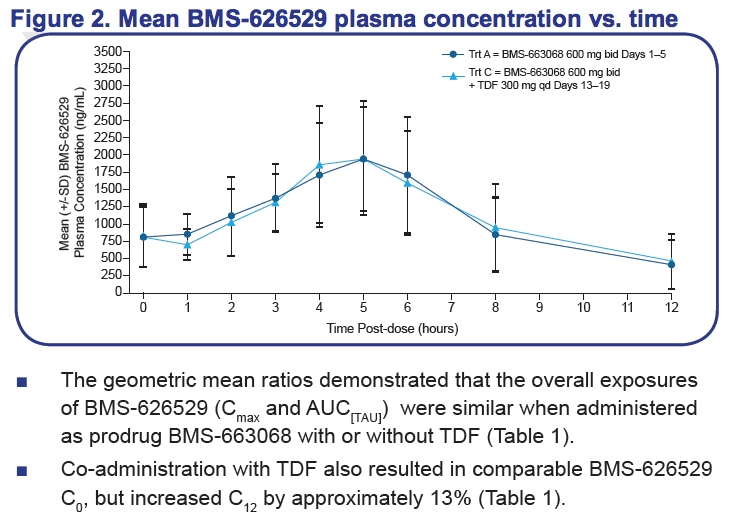
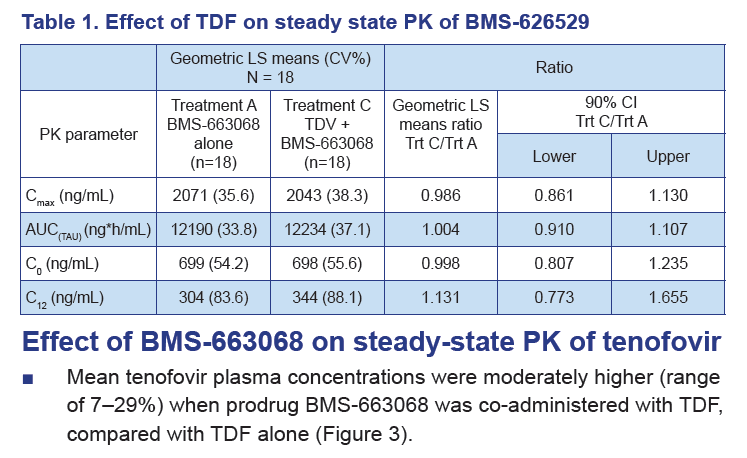
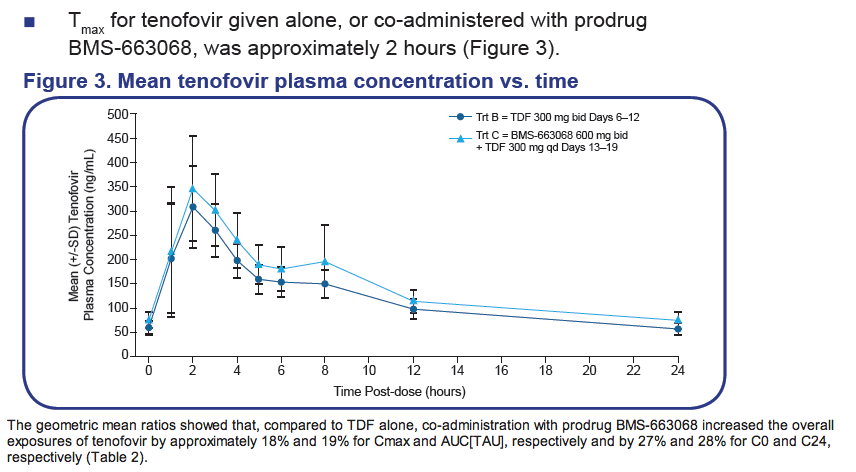
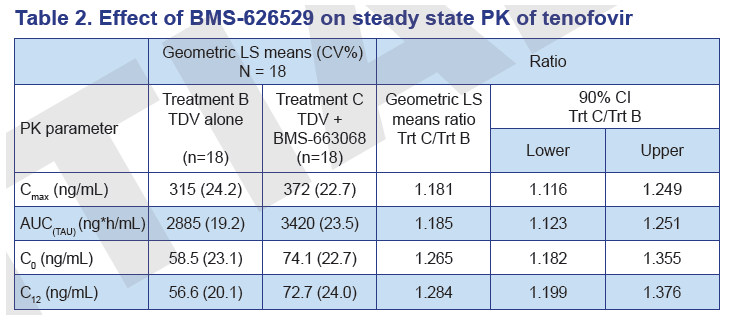
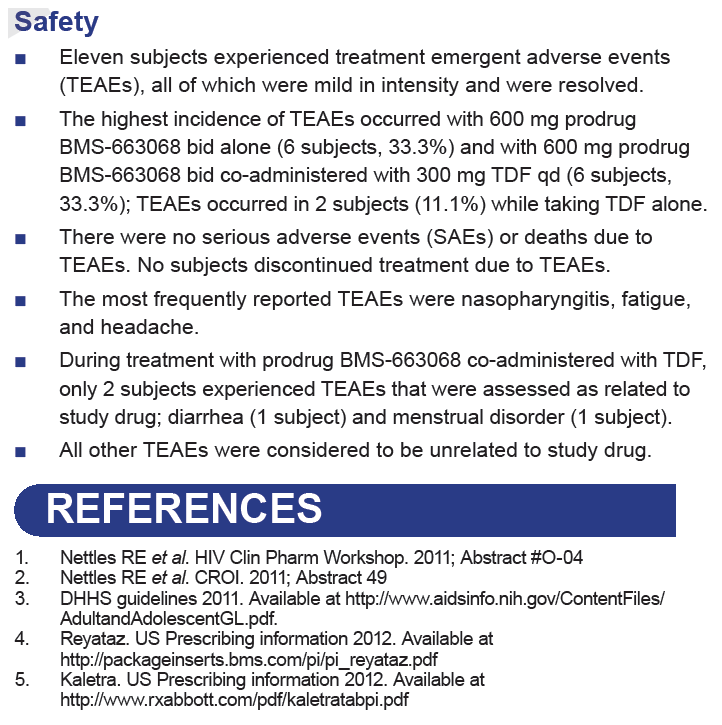
|
| |
|
 |
 |
|
|